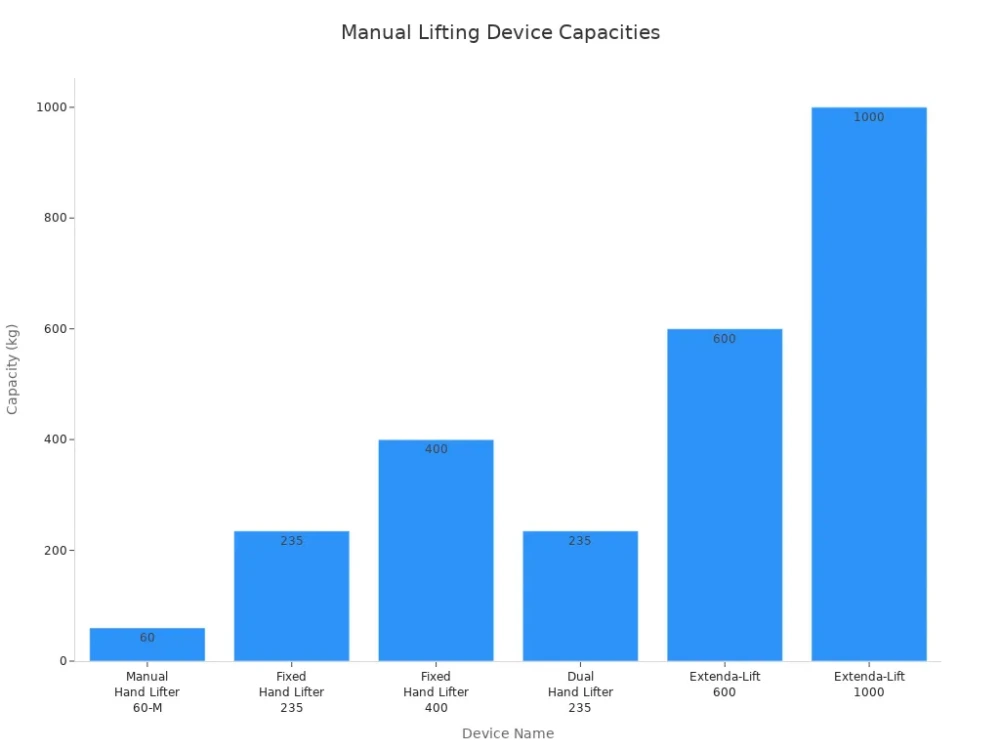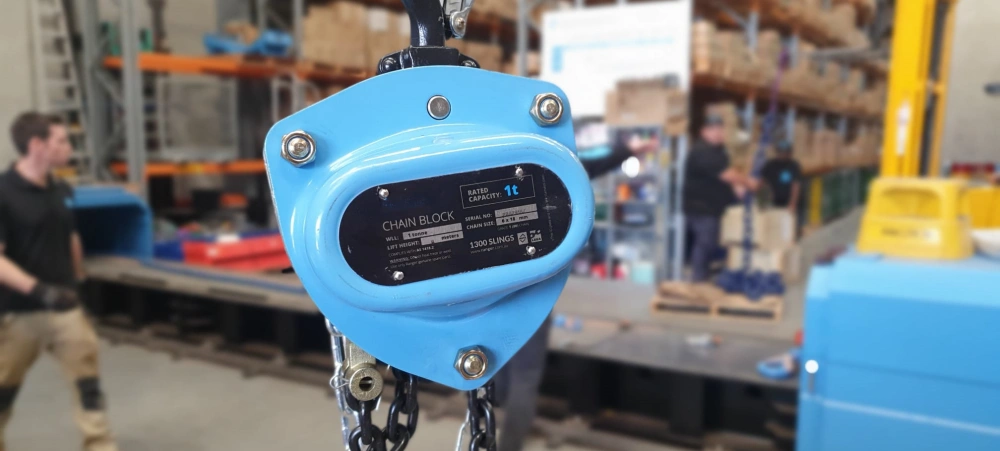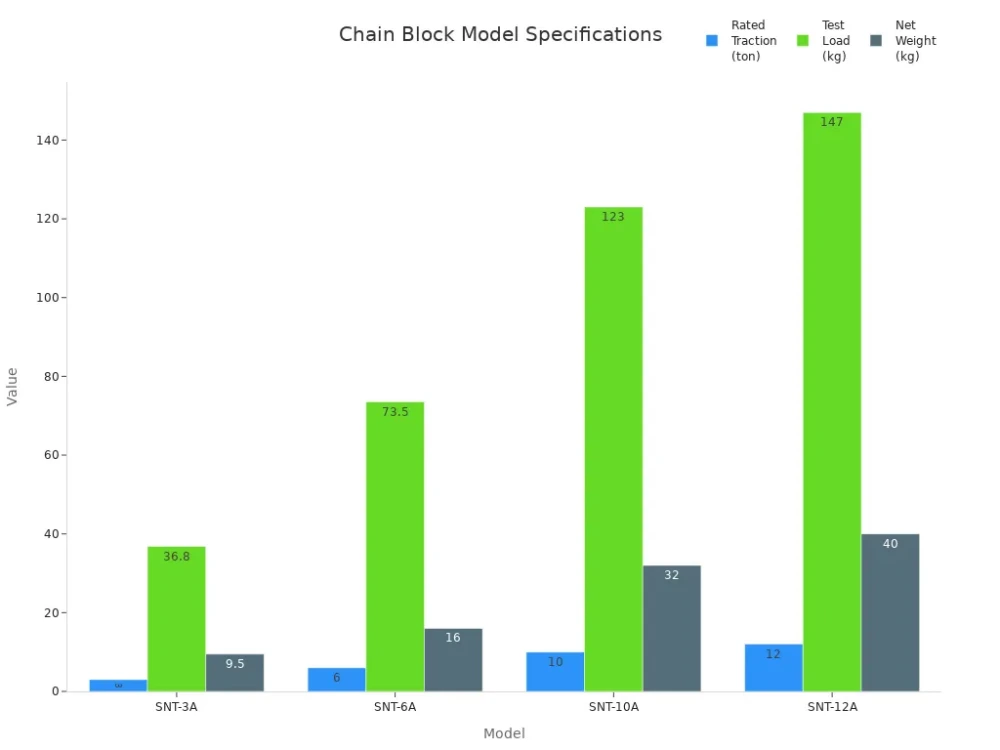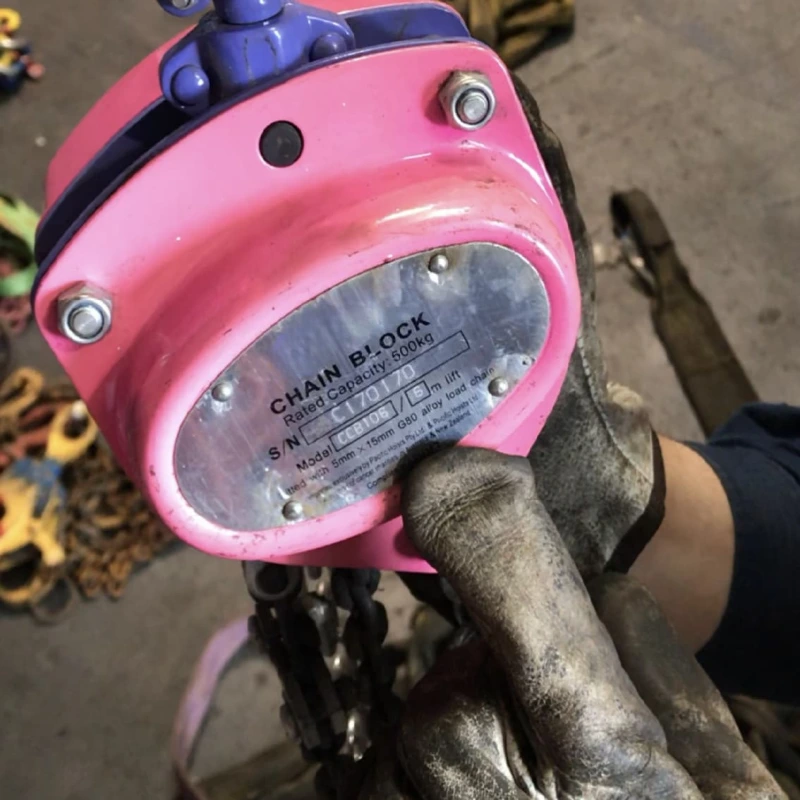When you compare a chain block vs a lever block, you face an important decision that affects your safety and productivity. You need to understand how each device operates, where you can use it, and what loads it handles best.
Understanding operational mechanisms, applications, and load capacities is crucial in selecting manual lifting devices as it directly influences safety, efficiency, and effectiveness in lifting operations.
Industry experts emphasize the importance of considering factors such as the rated capacity versus the working load limit (WLL), the weight and shape of materials, dynamic loads, and the specific requirements of the lifting tasks.

Industry trends show a shift toward ergonomic designs, smart lifting systems, and eco-friendly equipment to improve user comfort and reduce strain.
With Powerful Machinery’s expertise and certified product range, you can make a confident, informed choice.
Key Takeaways
Understand the operation methods: Chain blocks use a hand chain for vertical lifting, while lever blocks use a lever for precise control in various directions.
Choose the right tool for your task: Use chain blocks for heavy vertical lifts in construction, and lever blocks for flexible lifting in tight spaces.
Always check load capacities: Chain blocks can lift 0.5 to 9 tons, while lever blocks handle 0.25 to 6 tons. Select a device with a higher capacity than your load.
Prioritize safety: Inspect your lifting device before use, ensuring all components are in good condition and meet safety standards.
Consider your work environment: Choose equipment that suits your conditions, such as corrosion-resistant materials for outdoor use.
Chain Block vs Lever Block: Key Differences
Operation Methods
When you compare a chain block vs a lever block, you notice clear differences in how each device works. A chain block, also called a hand chain hoist, uses a continuous hand chain.
You pull the chain, and a gear system inside multiplies your force. This lets you lift heavy loads with steady, controlled movement. You can operate a chain block from a distance, which keeps you away from the load.
A lever block, sometimes called a come-along, uses a ratchet-and-pawl system. You move a lever back and forth to lift or pull the load. This method gives you precise, incremental control.
You must stand close to the hoist to use the lever. Lever blocks often include a “free-wheeling” mode, so you can quickly adjust the chain length before lifting.
Here is a table that summarizes the main operational differences:
Feature | Chain Block (Hand Chain Hoist) | Lever Block (Come-Along) |
|---|---|---|
Primary Action | Pulling a hand chain | Pumping an integrated lever |
Internal Mechanism | Gear reduction system | Ratchet-and-pawl system |
Operator Position | Operate from a distance | Operate up close |
Force Application | Indirect, through gears | Direct, through the lever |
Load Control | Steady, slow movement | Precise, incremental movement |
Slack Adjustment | Feed the hand chain | Free-wheeling mode |
Powerful Machinery designs both types of hoists with simplicity and durability in mind. You benefit from reliable operation and easy maintenance, which matches industry standards for safety and efficiency.
Application Directions
The chain block vs lever block debate often centers on where and how you use each tool. Chain blocks work best for vertical lifting. You often see them in construction, automotive shops, and factories. They help you install heavy equipment or move materials up and down.
Lever blocks offer more flexibility. You can use them for vertical, horizontal, or even angled lifting. This makes them ideal for tight spaces, high-altitude work, or when you need to pull or position loads with precision.
Lever blocks are common in equipment maintenance, pipeline installation, and confined areas where space is limited.
Here is a quick look at typical applications:
Type of Block | Common Applications | Industries |
|---|---|---|
Chain Block | Lifting heavy equipment, materials handling | Construction, automotive, manufacturing |
Lever Block | High-altitude work, equipment maintenance, pipeline installation | Confined spaces, assembly, calibration |
You can use lever blocks in narrow spaces because of their compact design.
Lever blocks give you precise control, which is important for safety.
Both types are made from durable, wear-resistant materials and require little maintenance.
Powerful Machinery’s manual lifting solutions meet the needs of these demanding environments. You can trust their products to perform reliably, whether you need steady lifting or precise positioning.
Load Capacity
Load capacity is a key factor in the chain block vs lever block comparison. Chain blocks usually handle heavier loads. You can find models that lift from 0.5 tons up to 9 tons. This makes them suitable for large construction projects and heavy machinery.
Lever blocks typically have a lower capacity, ranging from 0.25 tons to 6 tons. They are perfect for smaller loads or when you need to move or position items with care. Always check the rated capacity before use. Never exceed the limit, as this can cause accidents or equipment failure.
Here is a table showing typical load capacities:
Type of Hoist | Load Capacity Range |
|---|---|
Chain Block | 0.5 tons to 9 tons |
Lever Block | 0.25 tons to 6 tons |
Powerful Machinery’s chain blocks and lever blocks both meet strict international standards. You get certified lifting solutions that keep your work safe and efficient.
Tip: Always inspect your lifting device before use. Look for twisted chains or signs of damage. Safe operation starts with proper checks.
When you choose between a chain block and vs lever block, think about your lifting direction, space, and load size. Powerful Machinery gives you the quality and reliability you need for any lifting challenge.
Chain Block Overview
What Is a Chain Block?

A chain block is a manual lifting device that helps you raise and lower heavy loads with ease. You operate it by pulling a hand chain, which turns gears inside the device. These gears multiply your force, so you can lift much heavier objects than you could by hand.
The main parts of a chain block include the hand chain, load chain, gears, hooks, and a strong brake system. Each part works together to give you safe and controlled lifting.
Component | Description |
|---|---|
Hand Chain | Pulled by you to activate the lifting mechanism. |
Load Chain | Attaches to the load and moves up or down during operation. |
Gears | Amplify your force for efficient lifting. |
Hooks | Secure the load and the device to an anchor point. |
Brake System | Prevents the load from slipping or falling. |
You can see how these parts work together to make lifting safer and more efficient.
Typical Uses
You will find chain blocks in many industries because they handle tough lifting jobs. Construction workers use them to move building materials. Manufacturing plants rely on them to assemble heavy machinery. Mining operations need them for lifting equipment and ore.
Warehouses use chain blocks to handle large shipments. Even shipyards and oil and gas sites depend on chain blocks for their most demanding tasks.
Capacity Range | Common Industries | Applications |
|---|---|---|
1-3 tons | Manufacturing, Construction | Lifting materials, assembling machinery |
3-5 tons | Mining, Heavy Manufacturing | Handling heavier loads in tough environments |
Above 5 tons | Oil & Gas, Shipbuilding | Specialized lifting for extremely heavy equipment |

Advantages
You gain several benefits when you use a Powerful Machinery chain block:
You can lift heavy loads with minimal effort, thanks to the efficient gear system.
The brake system locks the load in place when you stop pulling, which keeps you safe.
Overload protection and a slip clutch prevent you from lifting more than the rated capacity.
Durable steel chains and hooks resist breaking, even in harsh conditions.
The compact design lets you use the chain block in tight spaces.
Regular inspections help you spot wear or damage early, so you can keep your lifting operations safe.
Powerful Machinery’s chain blocks meet strict international standards. You get reliable, certified equipment for every lifting challenge.
Lever Chain Hoist Overview
What Is a Lever Chain Hoist?
A lever chain hoist is a manual lifting tool that lets you lift, pull, or position heavy loads with precision. You operate it by moving a lever back and forth, which engages a ratchet mechanism. This action moves the load chain and raises or lowers the object.
Powerful Machinery’s HSH-AL Lever Chain Hoist features a lightweight aluminum body, making it easy for you to carry and use in different environments. The reinforced handle and ergonomic hand wheel help you work comfortably and safely.
You can rely on its non-slip safety nut and strong brake system to keep loads secure during operation.
Specification Category | Details |
|---|---|
Manufacturing Location | South Korea (MAGNA series) |
Gear Type | Machined, case-hardened gears for extra strength |
Component Size and Material | Over 18% more robust than competitors |
Load Testing Standards | Load tested to 150% of rated capacity |
Price Considerations | Competitive pricing for high-quality performance |
Common Uses
You can use lever chain hoists in many industries and situations. Their compact size and portability make them ideal for field operations and tight spaces. Here are some frequent use cases:
Industry/Field | Use Case Description |
|---|---|
Construction and Infrastructure | Erecting structures, positioning steel beams, and installing heavy equipment |
Manufacturing and Production | Lifting engines, assembly line maintenance |
Entertainment and Stage Rigging | Lifting and positioning lighting and sound equipment |
Rescue Operations | Vehicle extractions, lifting debris in emergencies |
Maintenance and Repair Work | Lifting heavy parts in hard-to-reach areas like wind turbines and bridges |
You can see how versatile lever chain hoists are. They help you tackle lifting tasks in places where other equipment cannot fit.
Advantages
When you choose Powerful Machinery’s lever chain hoist, you benefit from several key advantages:
You enjoy easy portability due to the lightweight aluminum body.
The ergonomic design reduces strain and helps prevent work-related injuries.
You can handle loads efficiently, whether you need vertical or horizontal movement.
Safety mechanisms protect you from accidents and ensure reliable operation.
The hoist meets strict international standards and undergoes rigorous load testing.
Tip: Always inspect your lever chain hoist before use. Check the chain, hooks, and safety features to keep your lifting operations safe.
Powerful Machinery’s lever chain hoists give you a dependable, ergonomic, and safe solution for lifting and positioning heavy loads in any environment.
Chain Block vs Lever Block: Comparison Table
Side-by-Side Features
You need to compare the main features of chain blocks and lever blocks before you choose a lifting device. Chain blocks use a hand chain and gear system. You pull the chain to lift or lower heavy loads. Lever blocks use a ratchet mechanism and a lever handle.
You move the lever back and forth to control the load. Chain blocks allow you to operate from a distance. Lever blocks require you to stand close to the device. Both types offer strong safety features and durable construction.
Here is a quick comparison:
Feature | Chain Block | Lever Block |
|---|---|---|
Operation Method | Pull the hand chain | Pump lever handle |
Mechanism | Gear reduction | Ratchet and pawl |
Operator Position | At a distance | Up close |
Direction of Use | Vertical lifting | Vertical, horizontal, angled |
Portability | Compact, easy to transport | Lightweight, highly portable |
Safety Features | Brake system, safety latch | Non-slip nut, reinforced handle |
Maintenance | Low | Low |
Tip: Always check the safety features before you use any lifting device. This helps you avoid accidents and keeps your work area safe.
Applications and Capacities
You will see differences in how chain blocks and lever blocks handle loads and where you use them. Chain blocks work best for lifting heavy items in vertical applications. You find them in construction, mining, and shipbuilding. Lever blocks give you more flexibility.
You use them for lifting, pulling, and positioning loads in tight spaces or at different angles.
The table below shows typical applications and load capacities:
Type of Hoist | Load Capacity | Applications |
|---|---|---|
Chain Block | Up to 1 Ton | Warehousing, logistics for lighter loads |
Chain Block | 1-3 Tons | Construction, manufacturing for intermediate loads |
Chain Block | 3-5 Tons | Mining, oil & gas, heavy machinery |
Chain Block | Above 5 Tons | Shipbuilding, large-scale manufacturing |
Lever Block | N/A | Manufacturing, assembly operations for precision |
When you compare chain blocks vs lever blocks, you see that chain blocks handle heavier loads and suit vertical lifting. Lever blocks excel in precision tasks and work well in confined spaces. You should match your choice to your job requirements and the environment.
Product Variants and Features
Powerful Machinery Chain Block Models
You can choose from several chain block models by Powerful Machinery. Each model fits different lifting needs. The 2 Ton Chain Block works well in workshops and for lifting engines. The 3 Ton Chain Block handles heavy-duty jobs on construction sites and in shipping yards.
Specification | 2 Ton Chain Block | 3 Ton Chain Block |
|---|---|---|
Load Capacity | 2,000 kg | 3,000 kg |
Dimensions (L×W×H) | 12×8×6 inches | 14×10×7 inches |
Weight | 15 kg | 22 kg |
Material | Grade 70 Alloy Steel | Grade 80 Alloy Steel |
Chain Diameter | 8 mm | 10 mm |
Applications | Workshops, engines, agriculture | Construction, heavy machinery, ports |
2 Ton Chain Block: You can use this model for light materials, engine lifting, and farm work.
3 Ton Chain Block: This model suits you if you need to lift heavy machines or work in ports.
Powerful Machinery Lever Chain Hoist Models
You have several options with Powerful Machinery’s lever chain hoists. The HSH-AL series stands out for its lightweight aluminum body and strong safety features. You can pick from models with capacities of 0.25, 0.5, 0.75, and 1.5 tons. Each model has a reinforced handle and a non-slip safety nut.
You can use these hoists in outdoor settings, tight spaces, or for precise positioning tasks. The ergonomic design helps you work longer with less fatigue.
You can rely on these lever chain hoists for both vertical and horizontal lifting. Their compact size makes them easy to carry and use anywhere.
Real-World Use Cases
Many companies trust Powerful Machinery’s lifting solutions. You can see their products in action across different industries.
Company Name | Industry | Description |
|---|---|---|
Vuteq | Automotive Supply | Used chain blocks for installing overhead cranes. |
Applied Aerospace | Aerospace Manufacturing | Installed hoists for precise lifting in California. |
Tyler Union Foundry | Iron Fitting Manufacturing | Used overhead cranes for heavy casting operations. |
Boxabl | Modular Home Fabrication | Improved efficiency with chain blocks in home production. |
U.S. Gypsum | Mining | Operated a 20-ton crane 400 ft underground for safe lifting. |
Customers like Ben Carter from Canada and David Müller from Germany praise the durability and reliability of Powerful Machinery’s products. You can trust these lifting devices to perform in tough environments and demanding projects.
Choosing the Right Device
Assessing Load and Application
You need to start by understanding your lifting needs. Calculate the total weight you plan to lift, including any rigging or accessories. Always match the hoist type to your job’s demands. If you need steady vertical lifting for heavy loads, a chain block works best.
If your task requires precise control or movement in tight spaces, a lever block gives you flexibility.
Before you select a device, consider these important factors:
Calculate the total load weight, including all rigging.
Match the hoist type—manual, lever, or electric—to your job’s speed and precision needs.
Inspect your chain and block for wear, damage, or deformation before every use.
Make sure your hoist has safety certifications for your region, such as CE or ASME.
Remember that your hoist is part of a system. Slings and clamps must also be rated for the load.
Choose a hoist with overload protection to prevent lifting dangerously heavy loads.
Tip: Powerful Machinery offers custom-made manipulators and a wide range of hoists, including manual, electric, and pneumatic options. You can find solutions for lifting heavy or awkwardly shaped items.
Environment and Frequency
Your work environment and how often you use your lifting device play a big role in your choice. If you work outdoors or in harsh conditions, select equipment with corrosion-resistant materials. Powerful Machinery’s lever chain hoists feature lightweight aluminum bodies that resist rust and damage.
Think about these points when choosing between a chain block and vs lever block:
Consider the environment where you will use the equipment.
Assess the lift height required for your operation.
Evaluate the weight capacity needed for safe lifting.
Frequent use in tough environments means you need durable equipment. Exposure to corrosive chemicals can weaken materials. Extreme temperatures can affect the strength of lifting equipment. Ultraviolet radiation may degrade materials over time.
Powerful Machinery’s products are tested for reliability in demanding conditions, so you can trust them for regular use.
Note: Powerful Machinery provides workstation cranes, overhead bridge cranes, and Jib Cranes for specialized environments. You can also choose lift tables for raising large, heavy loads safely.
Safety and Maintenance
Safety should always come first. You need to follow industry standards and manufacturer guidelines to keep your lifting operations safe. Powerful Machinery’s chain blocks and lever blocks meet strict certifications, including ISO, CE, and ASME.
Here is a table showing key safety standards:
Safety Standard | Description |
|---|---|
ASME B30.21 | Covers construction, inspection, testing, and maintenance of lever hoists. |
OSHA | Enforces safety standards in the workplace for hoisting equipment. |
ANSI | Provides voluntary consensus standards for lifting devices, ensuring reliability and safety. |
Follow these safety and maintenance practices:
Ensure all operators are trained in the proper use and care of lifting devices.
Conduct frequent inspections and document your findings.
Follow the manufacturer’s guidelines for routine maintenance.
Maintain records of training, inspections, and maintenance.
You should also check these items before every use:
Check markings and labels for legibility.
Test the hoist controls for responsiveness.
Inspect the hook for wear or deformation.
Operate the hoist without a load to check for smooth operation.
Examine the chain for excessive wear or damage.
Tip: Regular lubrication protects the lifting chain from premature wear and corrosion. Powerful Machinery’s certified products help you maintain a safe and efficient worksite.
When you compare a chain block vs a lever block, think about your load, application, environment, and safety needs. Powerful Machinery offers custom solutions and certified equipment to help you choose the right device for every lifting challenge.
Conclusion
When you choose between chain blocks and lever blocks, consider your lifting direction, load size, and workspace. Chain blocks work best for heavy, vertical lifts in factories or construction. Lever blocks give you flexibility for lifting or pulling in any direction, even in tight spaces.
Always select equipment with a higher capacity than your load and check for safety certifications. Powerful Machinery offers certified, durable solutions that help you lift safely and efficiently every time.
FAQ
What is the main difference between a chain block and a lever block?
You operate a chain block by pulling a hand chain for vertical lifting. You use a lever block by pumping a lever, which allows you to lift, pull, or position loads in any direction.
Can you use a lever block for horizontal pulling?
Yes, you can use a lever block for horizontal pulling. Its ratchet mechanism gives you control for moving loads sideways or at an angle.
Tip: Always check the rated capacity before starting any pulling task.
How do you choose the right load capacity?
You should calculate the total weight of your load, including any rigging. Select a device with a higher rated capacity than your load.
Device Type | Typical Capacity Range |
|---|---|
Chain Block | 0.5–9 tons |
Lever Block | 0.25–6 tons |
Are the Powerful Machinery lifting devices certified for safety?
You get certified equipment from Powerful Machinery. All chain blocks and lever blocks meet international standards like CE, ISO, and ASME.
Note: Certified devices help you maintain a safe worksite.
What maintenance does a manual hoist require?
You inspect chains, hooks, and brakes before each use. Lubricate moving parts regularly.
Check for wear or damage
Test controls without a load
Follow manufacturer guidelines for routine care


